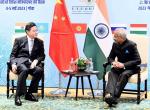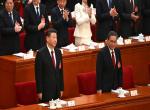To assess the outcome of the fourth BRICS summit at New Delhi on March 29, a look is required at the genesis of this grouping, its value for its members and the extent to which it can influence international decision-making.
The origin of BRICS lies in the RIC (Russia-India-China) group set up formally at Russia’s initiative in 2002 to promote multipolarity at a peak moment of American unilateralism and to give Russia a platform to exercise its great power role diminished by the Soviet Union’s collapse and Western geo-political pressures on its periphery.
Around 2006, Russia concluded that RIC had internal limitations because of India-China differences, and that the BRIC concept, with Brazil’s inclusion, would better subsume them, besides strengthening even more the political as well as the economic base of multipolarity. The inclusion of Brazil, the largest South American country and the fourth emerging economy identified by Goldman Sachs in 2001, gave a certain coherence to the group. It also facilitated Russia’s political re-entry into South America from where it had retreated after the Soviet collapse.
China, with its diplomatic and economic offensive in Africa and especially its expanded engagement with South Africa, put its imprint on the BRIC group by successfully pushing for the latter’s inclusion in December 2010. This has given greater geographical representation to the group and strengthened further its multipolar, non-Western character.
Russia’s interest in RIC/BRIC/ BRICS has been more political than economic. It lacks, in any case, the capacity to carve out an economic and commercial sphere of influence in these emerging economies. On the financial side, though, it has since 2006 spoken against the dollar as the principal international reserve currency as it gives the United States of America excessive influence in global affairs, besides inflicting on others the consequences of its consumer profligacy and financial mismanagement.
India’s approach has been practical. Initially, it too was perturbed by US unilateralist tendencies and felt pressure on nuclear and Pakistan related matters, and consequently supported Russian advocacy of multipolarity. The RIC format also enhanced India’s international stature in general and vis a vis China in particular. Its membership of a non-Western group with the potential to bring about a better global balance was consistent with its independent approach to international affairs. However, with its improved relationship with the US, especially after the nuclear deal transformed it strategically, India is sensitive to any undue anti-US/ Western thrust of the group.
India was not initially enthusiastic about RIC’s extension to BRIC politically as it lacked then its present profile. India had no issue with BRIC existing separately as an economic group to focus on World Trade Organisation matters and headed by commerce or trade ministers, rather than by foreign ministers as Russia wanted and succeeded in eventually bringing about. India had reservations about South Africa’s inclusion in order to preserve IBSA’s salience as a South-South grouping. While India benefits from RIC/BRIC politics that reduces Western domination, it has sought to de-emphasize the perceived anti-Western political logic of these groups by putting the accent on their economic agenda.
China was tentative towards RIC to begin with, but after the first meeting became more confident about its participation. It might not have wanted, initially, to play second fiddle to Russia or play into Russian hands against the US, or it might have been uncomfortable with India gaining an enhanced stature. The Chinese were even unresponsive to Indian moves to boost the economic content of RIC. But with its own outreach to India later and its economic penetration of South America and Africa that followed, it now participates actively within the group.
Now that China is the foremost economic power within BRICS, and is headed towards surpassing the US in economic size, its preponderance in the economic and financial agenda of the group will keep increasing. The internal equations within BRICS will inevitably move in China’s favour, principally at Russia’s expense, in great power terms. Even though both countries need each other strategically to counter US hegemony, and China’s economic stakes in the US being incomparably greater than those of Russia, it will be interesting to watch the eventual internal balance in the group on how far to challenge the West.
Western reaction to BRICS has moved from some strategic concern to a touch of indifference to renewed attention. The RIC seemed an embryonic strategic challenge to the West, but as its impact proved limited and as it was assumed that the relations of each member with the US surpassed in importance intra-BRIC relations, it ceased evoking much interest even with Brazil’s addition and the emergence of the overlapping BRIC group.
Today, with financial turmoil and economic difficulties sapping the self-confidence of Western countries, healthy growth rates in China and India aiding global economic recovery, and Brazil at last beginning to realize its potential, BRICS cannot be ignored. Western sceptics point, though, to intra-BRIC differences, especially between India and China, and the undercurrents of strategic discomfort between Russia and China, as an obstacle to any broad range genuine partnership between these countries.
Yet, what the BRICS countries collectively represent is impressive. They account for 43 per cent of the world’s population, more than 26 per cent of the global gross domestic product and the world’s land area, and hold four trillion dollars in combined foreign reserves. China and India are expected to become the first and the third largest economies by 2050, with Brazil and Russia in the fifth and sixth positions.
More concerted deliberations by them will influence the way in which the international community addresses the present imbalance in international political and economic governance. With every summit the BRICS agenda is becoming more substantive.
At the New Delhi summit the five countries called for greater representation of emerging and developing countries in global governance and expressed concern about the economic and financial policies of developed countries spilling over negatively into the emerging market economies. They lectured on the need to adopt responsible macroeconomic and financial policies, the need to avoid creating excessive global liquidity and the need to undertake structural reforms of their own. They criticized the slow pace of International Monetary Fund quota reforms and welcomed, without agreeing on any one in particular, the candidatures from the developing world for the World Bank presidency. They discussed the creation of a new development bank for infrastructure projects in BRICS and other developing economies, a project on which a joint working group will report to the next summit. An agreement on extending credits in local currency under the BRICS Interbank Cooperation mechanism has been reached.
All these are initial steps to obtain greater say in managing the global financial system and diluting the supremacy of the dollar, even as it is clear that progress on this will be slow and the biggest beneficiary will be China.
On political issues, the BRICS position on Iran challenges Western policy by clearly opposing military action against Iran, but the cautious formulation on Syria does not ignore Western and Arab concerns while rejecting regime change. Regrettably, Chinese reticence explains the absence of support from this group for India’s and Brazil’s candidature for permanent United Nations security council membership. This reflects the as yet unsettled political equations within the group that will detract from its global impact.
Published in The Telegraph 3rd May 2012









Post new comment